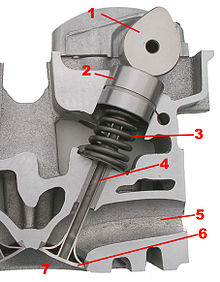Valve (piston machine)

1. Camshaft cams
2. Bucket tappets
3. Valve spring
4. Valve stem
5. Gas duct to inlet (fresh gas) or outlet (exhaust gas)
6. Valve plate that seals the combustion chamber (7) against the valve seat ring
For short, valve is the technical term for special valve assemblies for controlling the gas exchange for intermittently operating displacement machines , in particular piston machines and especially reciprocating piston engines with internal combustion such as the four-stroke engine . Technically, these valves are usually designed as poppet valves and, as an assembly with a strong return spring and a plunger drive, form the so-called valve train .
Depending on the function, each working space with pistons usually has at least one inlet valve and one outlet valve . Exceptions are two-stroke engines , which instead work with piston edge control or slot control and either manage without valves at all or, as in many two-stroke diesel engines, only use exhaust valves.
Alternatively, there are slide controls that are rarely used today.
Inlet valve

Inlet valves control the flow of fluid (gas or liquid) into the working space ; especially with combustion engines, the inflow of fresh charge from the intake tract into the combustion chamber.
outlet valve
Outlet valves control the delivery of fluid from the working space; especially with combustion engines, the emission of the burned exhaust gases in the exhaust system and exhaust . Conversely, with appropriately adjusted valve timing, you can also control simple forms of exhaust gas recirculation .
arrangement
In valve-controlled reciprocating engines such as the four-stroke engine , the valves are usually suspended in the cylinder head , which both closes off the combustion chamber and forms the bearing for the valve seat and valve train .
Hardly common are side valves (Side Valves), wherein the valves are disposed laterally next to the cylinders to the crankcase. The valve train and cylinder head are cheap to manufacture, the cylinder block is a bit more complex. The engine is more compact, but among other things, a hanging valve enables higher compression and better filling.
Multi-valve technology
Two or more valves are often installed in parallel for both inlet and outlet ( multi-valve technology ) in order to reduce the flow losses with a larger opening cross-section and to increase the engine output with a higher degree of delivery .